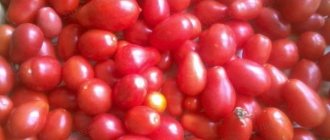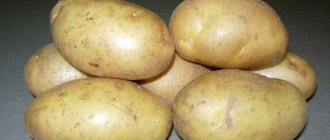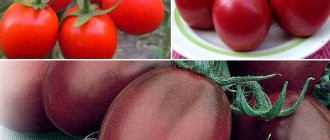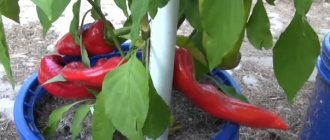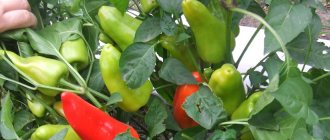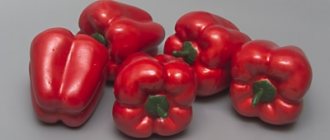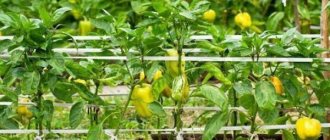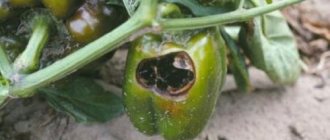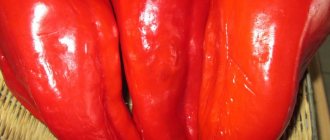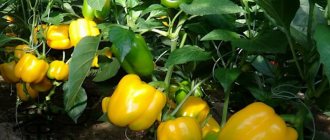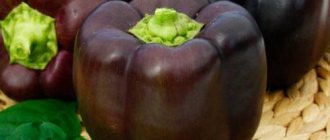Advantageous characteristics of the type
Ratunda sweet pepper belongs to the mid-season plant types. It ripens 95-100 days after pollination. The plant has a long, strong stem, from half a meter to a meter in height. The description of the variety includes the main qualities of the fruit:
- At ripeness they reach a weight of one hundred to one hundred and fifty grams.
- The thickness of the fleshy walls is from seven millimeters and above.
- Unripe fruits are dark green, turning red or yellow as they ripen.
- The pepper tastes sweet and hot, with a honey aftertaste.
If you grow sweet pepper varieties correctly, in warm summers they produce from three to five kilograms of tasty vegetables per square meter.
High-yielding pepper variety Olenka
Among the early ripening varieties of heat-loving vegetables, Olenka pepper can be distinguished. It is distinguished by its high yield - up to nine kilograms of juicy sweet hearths are obtained from one square meter. Their weight is usually ninety grams. Characteristics of culture include:
- height of a medium-sized bush;
- drooping fruit of a flat-round shape with slight wrinkles;
- thickness of the fleshy wall is 7 millimeters;
- color from dark green to red.
It is better to grow the plant under film coverings.
Representatives of round peppers
There are few varieties of vegetables similar to Ratunda pepper, but they are all popular among summer residents. Some please with early ripening, others with medium and late ripening. It depends on the growing region and summer weather conditions. When choosing one variety or another, you need to decide on the purpose of using the fruit. If cutting a vegetable is necessary, then the shape of the fruit does not play a role here.
But stuffed fruits should have a regular, preferably round, shape. Small peppercorns are also good to preserve.
Popular semi-standard variety
It’s not for nothing that the Kolobok pepper is called that, because its fruits are spherical with almost no edges. Thick walls can be nine to fourteen millimeters. And the size of the fruit is 5 by 8 centimeters with a weight of ninety grams or more. Kolobok reaches technical ripeness after 108-112 days. In this case, the fruits will be light green. They will turn red if 140-158 days have passed since the first shoots. And the taste will depend on the color of the vegetable. Red fruits are sweeter than green ones.
There are only excellent reviews about Kolobok pepper. All summer residents note its ease of care, rapid ripening, and the sweet taste of its thick walls. I especially like to use the fruits for canning along with tomatoes and preparing stuffed vegetables.
What does a representative of the variety look like?
The pepper was bred by Polish specialists. It is distinguished by its yield and thick fruit walls.
The plant looks like this:
- The bush is medium in height (up to 80 cm), branched.
- The leaves are dark green and large.
- The shape and size of the flowers are the same as those of other representatives of the culture.
- Fruits growing upward. The peduncle is thick and strong.
- The shape is typical for gogoshars - tomato-shaped or flat-round. The surface is glossy, highly ribbed (pictured).
- Technically ripe peppers are dark green. When fully ripe, the fruits become bright red.
- The small size (average weight up to 90 g) is compensated by thick walls.
- In cross section, the pepper has 4 chambers. There are few seeds.
Pepper is endowed with a rich taste and aroma. The fruits are used universally in cooking.
| Type of growth, bush height | Bushy up to 80 cm |
| Ripe fruit color | Bright red |
| Planting scheme | 50x50 cm |
| Weight, length and shape of the fruit | Up to 90 g, 3-4 cm, flat-round (tomato-shaped) |
| Ripening period, yield | Early ripening (85-90 days). In a greenhouse up to 9 kg/m2. In exhaust gas 5-7 kg/m2 |
| Drop off point | exhaust gas/greenhouse/greenhouse |
| Diseases | Resistant to root rot, tolerant to powdery mildew and ascochyta blight |
| By type of use | Universal |
| Flowering type | Female |
Ruby sweetness
Excellent canned food is made for the winter if you use Ruby pepper. It is grown in regions with different climatic conditions in greenhouse conditions and open ground. The height of the bush is no more than half a meter. The round-flattened fruits begin to ripen 160-178 days after emergence. At first they are light green in color, then gradually turn red, acquiring a ruby hue. Peppers reach a weight of 110-150 grams. From one square meter you can harvest over three kilograms of juicy vegetables.
Pepper "Gogoshary": characteristics and description of the variety, ratunda and other types
Gogoshary pepper belongs to the Moldovan group of pepper varieties, bred at a local research institute. It has spherical, rather wide, fleshy fruits. It is most often used in the preparation of vegetable salads, pickling, sauces, meat dishes and, of course, stuffed peppers.
Its main advantages are:
- fruit fleshiness,
- high productivity,
- adaptability to ripening,
- transport tolerance,
- presence of a large list of useful properties,
- pleasant honey shade of taste with bitterness,
- low energy value (calorie content),
- consumption in raw and prepared form.
The main disadvantages include:
- intolerance to soil drying out,
- intolerance to the lack of sufficient light,
- requires regular feeding,
- resistance to pests,
- fragility of the root system.
Main types of Gogoshar
Ratunda pepper is a fleshy fruit with unique tenderness. One fruit reaches a maximum weight of 100-150 grams with wide “lobar” walls that have rounded ribs.
Ruby pepper is a semi-spreading, medium-sized (40-60 cm), standard plant. Fruits at the technical stage of maturity are green, while at the biological stage they are dark red in color.
Kolobok pepper looks like small tomatoes with a diameter of 4 to 7 cm and weighing up to 160 grams and has more than decent taste.
Olenka pepper is an early-ripening type of sweet pepper intended for sowing both in greenhouse conditions and in ground conditions. The weight of a ripe fruit fluctuates around 90-100 grams. There is no bitter taste. The wall thickness is slightly less than that of its counterparts, 6-7 mm.
Pepper Sweetie looks like a miniature version of the above-mentioned varieties, because... an individual fruit reaches a maximum of 40 grams. But at the same time it is in no way inferior to them in taste.
Sweet candy
A hybrid of the round type, Sweetie pepper can have a color from yellowish-green to red. The round-cone-shaped shape with the fleshy, aromatic pulp of the vegetable allows it to be consumed fresh or preserved with whole fruits. They are small - only forty to fifty grams in weight. But the wall thickness reaches five to seven millimeters. The peculiarity of the hybrid is:
- early ripeness after 85-95 days;
- height of the bush is forty to sixty centimeters;
- high yield - kilogram per bush;
- resistance to diseases - fusarium, rot, viral mosaic.
With good care of the plant, you can get the first fruits as early as May.
Advantages and disadvantages
Pros:
- precocity;
- friendly maturation;
- extended fruiting period (until autumn frosts);
- versatility of cultivation;
- weather resistance;
- adaptability to different climates;
- high threshold of resistance to infectious pathogens;
- excellent marketability and taste;
- transportability and shelf life up to 1.5 months.
Minuses:
- need for sun, organic and mineral nutrition.
Features of cultivation
All vegetable plants that produce round fruits are similar to the Gogoshary pepper variety. It is not for nothing that they are united under this common name. The peculiarity of their cultivation is:
- growing through seedlings at an air temperature of 25 degrees;
- picking seedlings;
- planting in high beds;
- mulching the soil around the bushes;
- regular watering and fertilizing with mineral fertilizers;
- harvesting during the period of acquiring technical maturity.
The seeds of a heat-loving crop are planted for seedlings in February, since its age must reach seventy days before transplantation.
Vegetable seedlings should be picked as soon as they have two true leaves. It is better to plant them in separate pots. As soon as the risk of spring frosts goes away, the plant is planted, covering it with paper caps for the first time. The seedlings are placed in holes measuring 30 x 30 centimeters with a distance of 25 centimeters from each other. Sweet varieties should not be planted next to bitter ones, otherwise they will be pollinated and their taste will become different.
Water the vegetable plant frequently and abundantly. Feeding begins ten to twelve days after planting. First, mullein, diluted in a ratio of 1:5 or bird droppings - 1:15. Then dissolve thirty grams of ammonium nitrate, forty grams of superphosphate, and seventy grams of potassium salt in ten liters of water. Add one liter of nutrient solution to each bush. The interval between feedings is two to three weeks.
Vegetable stems are tied when there are a lot of fruits and there is a possibility that they will break. There is no need to plant the vegetable. Pepper fruits are harvested when they reach technical maturity, that is, they become an even green color. To make the peppercorns turn red faster, they are placed in a cool place in a canvas bag.
Ripe red peppers are used to prepare various canned products. It's good and fresh in salads.
If peppers are grown in a greenhouse, then it is necessary to warm the room well before planting, laying manure around the edges. Vegetables are only planted in a warm greenhouse in early May. You can alternate beds with peppers with tomatoes. The fertile soil in the greenhouse will allow you to plant up to six vegetable bushes on one square meter.
During the pepper growing season, the greenhouse must be ventilated, trying to maintain the air temperature within 25-27 degrees and humidity at 85 percent.
Pepper Ratunda, or Gogoshary, is popular for good reason. You can prepare many delicious dishes from it both on weekdays and holidays.
Pepper Kolobok variety description
The Kolobok pepper variety is an early ripening variety. More than 130 days pass from the appearance of large-scale shoots to maturity. The technical readiness stage is about 115 days. The variety is suitable for cultivation in protected and open ground.
Pepper Kolobok
- Bush part. Pepper of this variety is a low-growing plant. Rarely reaches a height of more than 40cm. It is a semi-standard compact plant with dense foliage in large quantities.
- Fruit. The fruits of the Kolobok pepper variety are spherical in shape, which is what gave the variety its name. The fruits on the plant are drooping. At the stage of technical maturity they have a light green tint. When fully ripe, they take on a rich dark red color. The weight of the fetus is more than 150g. And the wall thickness on average reaches 9mm. The fruits taste good. The aroma is strong, characteristic peppery.
- Disease resistance. Peppers are resistant to most of the known diseases that commonly affect sweet peppers, including verticillium wilt, black mold, blossom end rot, and viral mosaic.
- Application. The variety is excellent for both fresh consumption and canning, but much less frequently. Often used for making salads. For its taste, it is most often used fresh and in salads and for stuffing.
- Productivity. On one square meter of land you can get more than 3 kg. ready peppers. With proper and additional care of plants, this figure can easily reach 5 kg.
Thanks to its unique shape and excellent taste, the Kolobok sweet pepper variety will be an excellent decoration for both the festive and everyday tables. Good disease resistance will allow gardeners not to worry about its safety. However, peppers may require good care and nutrient feeding. This will help you get higher yields.
Wall thickness
When picking or transplanting peppers, a mixture of ash and humus is used in a ratio of 1:2. During growth in open ground, peppers also need to be fertilized. More often than others, urea, cow and chicken manure, as well as nettle infusion are used for feeding.
When growing peppers, you should not forget about pests. They can cause a lot of problems for plants in open ground. Plants grown in greenhouses are less susceptible to pests due to their physical protection.
Sweet pepper on a bush
You should keep the pepper beds clean, removing weeds in a timely manner. Pests and diseases can breed in them. At the slightest sign of pests, protective actions should be taken immediately, including the use of insecticides, if necessary.
Description and characteristics of the variety
Sweet pepper Olenka belongs to the line of early ripening varieties. Early harvests can be harvested within 100-105 days. The variety is represented by 2 breeding groups, the plants have differences.
Bell pepper Olenka from the originator “Siberian Garden” has powerful, strong stems of medium length. The height of the shoots is within 45-50 cm. The leaves are dark, with slight wrinkles. The fruits have a cone shape. What features should you know about sweet peppers:
- average weight 100-130 g;
- pericarp fleshy, juicy;
- the pulp is aromatic, sweet;
- color bright red;
- skin with glossy tints;
- length 10-12 cm.
Olenka pepper from Aelita is shaped like the well-known and beloved Gogoshar: the fruits are flat-round, have a wrinkled surface with ribs. For peppers:
- weight 90-100 g;
- pericarp 6-7 mm;
- ruby coloring;
- the taste is sweet.
The bushes grow up to 60-70 cm, have a closed arrangement of stems.
Description of the Olenka variety, reviews, photos
Currently, Olenka pepper varieties are produced by 2 agricultural companies, and these peppers are very different from each other. Here are descriptions of both varieties.
Sweet pepper Olenka from the Siberian Garden
An early, low-growing variety of bell pepper, resistant to unfavorable conditions, for open ground and film shelters.
The bush is compact, sparsely leafed, 45-50 cm high, with bouquet fruiting and friendly ripening of numerous fruits.
The fruits are upright, prism-shaped, light cream in the stage of technical ripeness, bright red in the biological stage, weighing 100-130 grams, juicy, excellent taste. Wall thickness 7-8 mm.
Advantages of the variety : intensive fruiting and early ripening, high commercial and technological qualities.
Pepper Olenka from Aelita
An early-ripening, productive variety of sweet pepper for greenhouses and open ground.
The plant is closed, of medium height. The leaf is medium sized, green to dark green, slightly wrinkled.
The fruits are drooping, flat-round, strongly ribbed, dark green in technical ripeness, dark red in biological ripeness, weighing 90-100 grams, good taste without bitterness. The wall thickness of the pepper is 6-7 mm.
The yield of marketable fruits under film covers is up to 9.0 kg/sq.m.
Olenka pepper is included in the State Register of the Russian Federation.
Ratunda pepper is a representative of sweet varieties of vegetables, characterized by a rounded fruit shape with moderate ribbing. Peppercorns have thick, fleshy walls and have a honey taste with a slight spicy bitterness. Another name for the pepper variety is Gogoshary.
Landing
The sowing period lasts from mid-February to the end of March. The seed material is soaked, and potassium permanganate or Fitosporin is used for disinfection. The soil for planting is disinfected by calcining or pouring boiling water.
What are the nuances of caring for seedlings:
- irrigation with warm water;
- maintaining a constant temperature (before germination 26-28 degrees, then 20-25 degrees);
- dive with 2 leaves;
- feeding after transplantation (solution of urea, urea, mullein, Azotovit);
- hardening for 10 days before replanting.
Olenka - sweet pepper plant variety
Variety characteristics:
Properties of the Olenka variety:
Recommended region on the map:
Information on admission Sweet pepper Olenka from the Register of the State Variety Commission of the Russian Federation
Application for admission No. 40692, registered 2003-12-16. The Sweet Pepper Olenka variety was included in the register of approved varieties in 2006. Approved for use in regions: All regions.
The originator of the Sweet Pepper Olenka variety is:
Other plant varieties Sweet pepper
Search for variety by name
Variety selection
Question to the portal experts
If you haven't found the answer to a question, don't hesitate to ask an expert.
Have you already planted Sweet Pepper Olenka?
Tell us if you liked this variety? Will you plant it again?
Register or Login so you don't have to enter your Name and Email every time
Thanks for the comment!
No comments yet, be the first!
A portal for those who love their dacha
Help our site develop!
Please read this message, it will not take up much of your time!
We so need your comments and questions to understand in which direction we should develop.
Sweet pepper Olga F1
Olga is able to surprise even the most demanding summer residents and gourmets!
pepper Olga
I grew Olga in the 2021 season in a greenhouse and will tell you below about my growing experience and my impressions.
Sowing
Sowing was done on February 17, 2021 with dry seeds - shoots appeared on the 8th day, 25th.
I sowed it in a mixture of Ogorodnik soil and Charaevsky vermicompost in a ratio of 70:30% immediately into half-liter cups perforated with a hot awl. The germination rate of Olga pepper seeds is 100%.
I grew it in a city apartment, first in a room with additional lighting, and in April I moved it to a glassed-in balcony.
Olga in the greenhouse
I transplanted the seedlings into the soil of the greenhouse in early May, as a result of which the plants took a long time to take root (it was quite cool), but they were definitely all tall and strong and none of them died.
I got a strongly branching, spreading bush reaching a height of 60-80 cm, in need of support
Olga pepper is a strong, juicy, sweet, fragrant fruit of a flat-round shape, glossy, green in technical ripeness, dark red in biological ripeness. They look very interesting when stuffed, thanks to their incredibly attractive shape.
Fruit weight is 90 grams, wall thickness is 6-8 mm. The peppers have an interesting, segmented shape, like fused melon slices, similar to a pumpkin. The walls of the fruit are thinner than those of Gogoshar peppers, but in terms of originality and bright taste I would put them on a par.
The yield is 5 kg/m2 - corresponds to the declared one; I collected 7-8 peppers from one plant.
Application
Use - universal (fresh consumption, canning and stuffing). I also froze it for stuffing for the New Year's table.
Peculiarities
Distinctive features: friendly yield of the harvest, high taste and technological qualities, unusual, original shape of the fruit, keeping quality - they lay on the balcony in the dark for about two months without any problems. Yes, the 2021 season was rich in peppers.
Manufacturer: Agrofirm SeDeK LLC, Domodedovo, Moscow region
In the city administration of Tolyatti on January 19, Zhigulevsk on January 20 and Novokuibyshevsk on January 13, 2021
The first lectures were held for students of the School of Gardeners project in the Samara region.
Gardening school in Zhigulevsk
The speakers of this event were Svetlana Yuryevna Zhurikova - Acting Deputy Director for Economics and Finance of the State Budgetary Institution of Further Education "Samara - ARIS" and Irina Vasilievna Ruzaeva, Candidate of Biological Sciences and Head of the Flora Department at the Samara Botanical Garden.
Svetlana Zhurikova gives a lecture in the administration of Tolyatti
Svetlana Yuryevna widely covered the topic of organizing the production of horticulture and vegetable gardening products. She clarified the issues of profitability of dacha farming, and also gave the basic concepts of the legal side of entrepreneurial activity for people who have and want to sell their surplus from their dachas.
Irina Vasilievna covered the topic of soil quite widely - its formation, types, classification and treatment. The history of studying soils on the territory of the Samara region dates back to the 19th century and Irina Vasilievna dwelt on this topic in detail, also showing a map of soils in the Samara region.
The participants of the event quite actively participated in the dialogues, asked questions and shared their personal experiences.
I.V. Ruzaeva advises students of the School in Zhigulevsk
Leaving the assembly hall of the mayor's office, people asked questions to the main characters - Natalya Leonidovna Mitroshenkova, Irina Vasilievna, Svetlana Yuryevna, exchanged contacts and, in general, were very satisfied.
I would also like to note the fact that in Novokuybyshevsk not only pensioners and people of pre-retirement age, but also young, very active people gathered for the lecture.
The latter cannot but rejoice, since without special knowledge of agricultural technology for cultivating horticultural and vegetable crops, as well as ornamental crops in dachas, it is very difficult to quickly and efficiently conduct your business activities and competently distribute your investments in it.
Gardening school in Novokuibyshevsk
The organizers of the meeting express their deep gratitude personally to the mayor of Zhigulevsk, Dmitry Kholinuz, for the efficiency in resolving organizational and information issues.
Novokuybyshevsk School of Gardeners
I will soon continue publishing on the materials presented at the lectures of the School of Gardeners, which you can start reading both on social networks and on the websites of the Union of Gardeners of Russia and Elena-dacha.ru.
Website addresses:
www.fprcxc.ru
www.elena-dacha.ru
Source: https://elena-dacha.ru/perec-sladkij-olga-f1/
